2 3d drawings contour lines
ggplot2 can not draw true 3D surfaces, just you can use geom_contour(), geom_contour_filled(), and geom_tile() to visualise 3D surfaces in 2nd. To specify a valid surface, the data must contain ten, y, and z coordinates, and each unique combination of ten and y can appear at most once. Contouring requires that the points tin can be rearranged so that the z values form a matrix, with rows respective to unique ten values, and columns corresponding to unique y values. Missing entries are allowed, just contouring will merely exist done on cells of the grid with all four z values nowadays. If your data is irregular, you tin interpolate to a grid earlier visualising using the interp::interp() part from the interp package (or one of the interpolating functions from the akima package.)
Usage
geom_contour ( mapping = NULL, data = NULL, stat = "contour", position = "identity", ..., bins = NULL, binwidth = NULL, breaks = Null, lineend = "butt", linejoin = "circular", linemitre = ten, na.rm = FALSE, evidence.legend = NA, inherit.aes = True ) geom_contour_filled ( mapping = Zero, data = NULL, stat = "contour_filled", position = "identity", ..., bins = Goose egg, binwidth = NULL, breaks = Nada, na.rm = FALSE, prove.legend = NA, inherit.aes = True ) stat_contour ( mapping = Nada, data = NULL, geom = "contour", position = "identity", ..., bins = Cipher, binwidth = NULL, breaks = NULL, na.rm = FALSE, show.legend = NA, inherit.aes = TRUE ) stat_contour_filled ( mapping = Naught, data = NULL, geom = "contour_filled", position = "identity", ..., bins = Nil, binwidth = Zip, breaks = Cipher, na.rm = Fake, testify.legend = NA, inherit.aes = TRUE ) Arguments
- mapping
-
Fix of artful mappings created by
aes()oraes_(). If specified andinherit.aes = TRUE(the default), information technology is combined with the default mapping at the elevation level of the plot. Yous must supplymappingif there is no plot mapping. - information
-
The information to be displayed in this layer. There are iii options:
If
NULL, the default, the data is inherited from the plot data equally specified in the call toggplot().A
information.frame, or other object, will override the plot data. All objects volition be fortified to produce a data frame. Come acrossfortify()for which variables will be created.A
functionwill be called with a unmarried argument, the plot data. The render value must be ainformation.frame, and will be used as the layer data. Afunctioncan be created from aformula(e.thousand.~ caput(.x, 10)). - stat
-
The statistical transformation to employ on the data for this layer, as a string.
- position
-
Position adjustment, either every bit a cord, or the result of a telephone call to a position adjustment part.
- ...
-
Other arguments passed on to
layer(). These are often aesthetics, used to fix an artful to a stock-still value, likecolour = "cherry"orsize = 3. They may too exist parameters to the paired geom/stat. - bins
-
Number of contour bins. Overridden by
binwidth. - binwidth
-
The width of the contour bins. Overridden past
breaks. - breaks
-
Numeric vector to fix the contour breaks. Overrides
binwidthandbins. By default, this is a vector of length x withpretty()breaks. - lineend
-
Line terminate style (round, butt, square).
- linejoin
-
Line join style (round, mitre, bevel).
- linemitre
-
Line mitre limit (number greater than 1).
- na.rm
-
If
Simulated, the default, missing values are removed with a warning. IfTRUE, missing values are silently removed. - evidence.legend
-
logical. Should this layer be included in the legends?
NA, the default, includes if whatsoever aesthetics are mapped.FALSEnever includes, andTRUEalways includes. It can as well be a named logical vector to finely select the aesthetics to display. - inherit.aes
-
If
FALSE, overrides the default aesthetics, rather than combining with them. This is about useful for helper functions that define both data and aesthetics and shouldn't inherit behaviour from the default plot specification, e.yard.borders(). - geom
-
The geometric object to use display the information
Aesthetics
geom_contour() understands the post-obit aesthetics (required aesthetics are in bold):
-
x -
y -
alpha -
colour -
group -
linetype -
size -
weight
Learn more about setting these aesthetics in vignette("ggplot2-specs").
geom_contour_filled() understands the following aesthetics (required aesthetics are in assuming):
-
10 -
y -
alpha -
colour -
fill -
group -
linetype -
size -
subgroup
Learn more almost setting these aesthetics in vignette("ggplot2-specs").
stat_contour() understands the following aesthetics (required aesthetics are in bold):
-
x -
y -
z -
grouping -
club
Learn more about setting these aesthetics in vignette("ggplot2-specs").
stat_contour_filled() understands the following aesthetics (required aesthetics are in bold):
-
x -
y -
z -
fill -
group -
lodge
Larn more about setting these aesthetics in vignette("ggplot2-specs").
Computed variables
The computed variables differ somewhat for contour lines (computed by stat_contour()) and contour bands (filled contours, computed by stat_contour_filled()). The variables nlevel and piece are bachelor for both, whereas level_low, level_high, and level_mid are only available for bands. The variable level is a numeric or a factor depending on whether lines or bands are calculated.
-
level -
Height of profile. For contour lines, this is numeric vector that represents bin boundaries. For profile bands, this is an ordered cistron that represents bin ranges.
-
level_low,level_high,level_mid -
(profile bands only) Lower and upper bin boundaries for each band, equally well the mid point between the boundaries.
-
nlevel -
Height of profile, scaled to maximum of 1.
-
piece -
Contour piece (an integer).
Come across also
Examples
# Basic plot v <- ggplot ( faithfuld, aes ( waiting, eruptions, z = density ) ) v + geom_contour ( )  # Or compute from raw data ggplot ( true-blue, aes ( waiting, eruptions ) ) + geom_density_2d ( )
# Or compute from raw data ggplot ( true-blue, aes ( waiting, eruptions ) ) + geom_density_2d ( )  # \donttest{ # employ geom_contour_filled() for filled contours five + geom_contour_filled ( )
# \donttest{ # employ geom_contour_filled() for filled contours five + geom_contour_filled ( ) 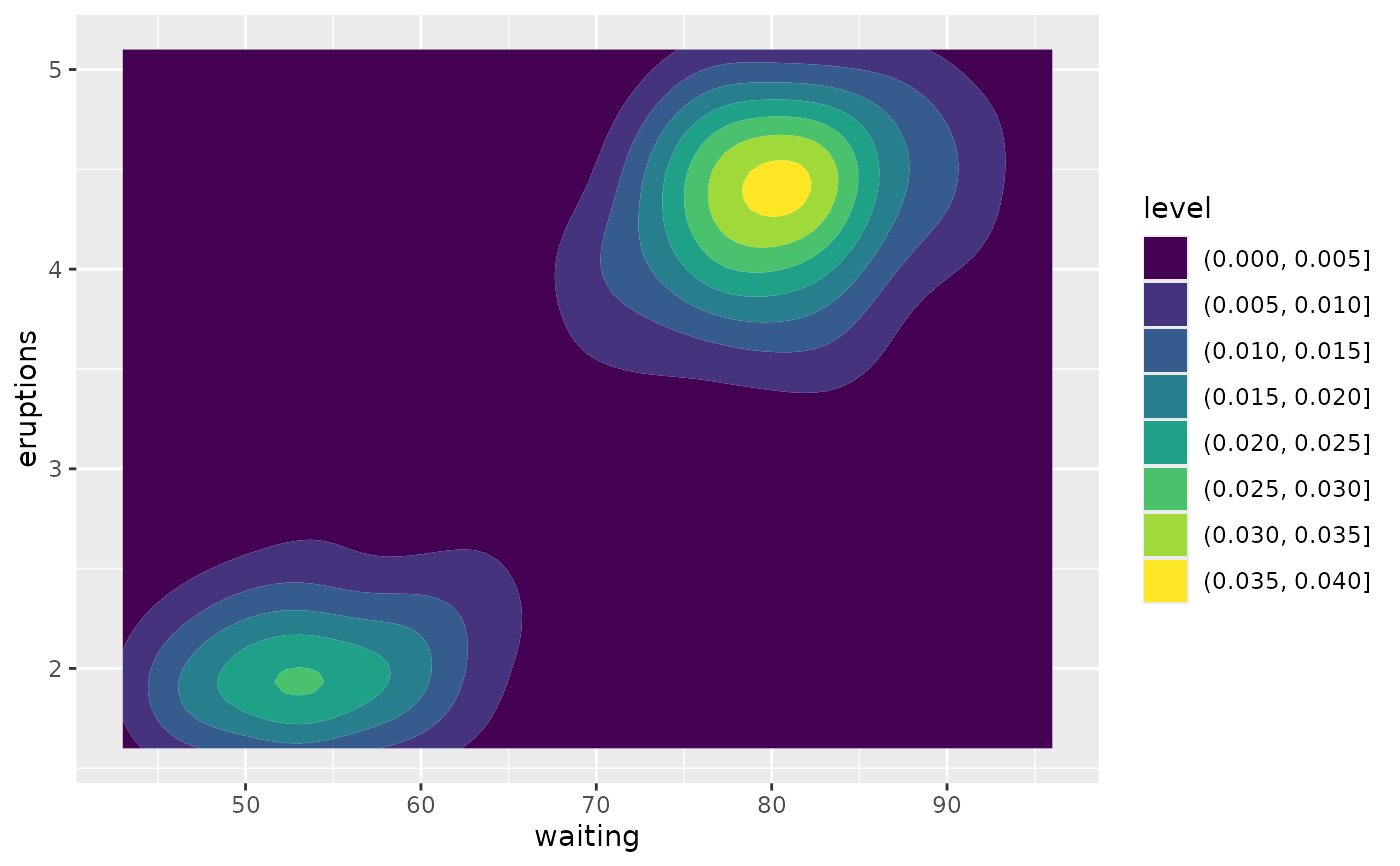 # Setting bins creates evenly spaced contours in the range of the data 5 + geom_contour (bins = 3 )
# Setting bins creates evenly spaced contours in the range of the data 5 + geom_contour (bins = 3 ) 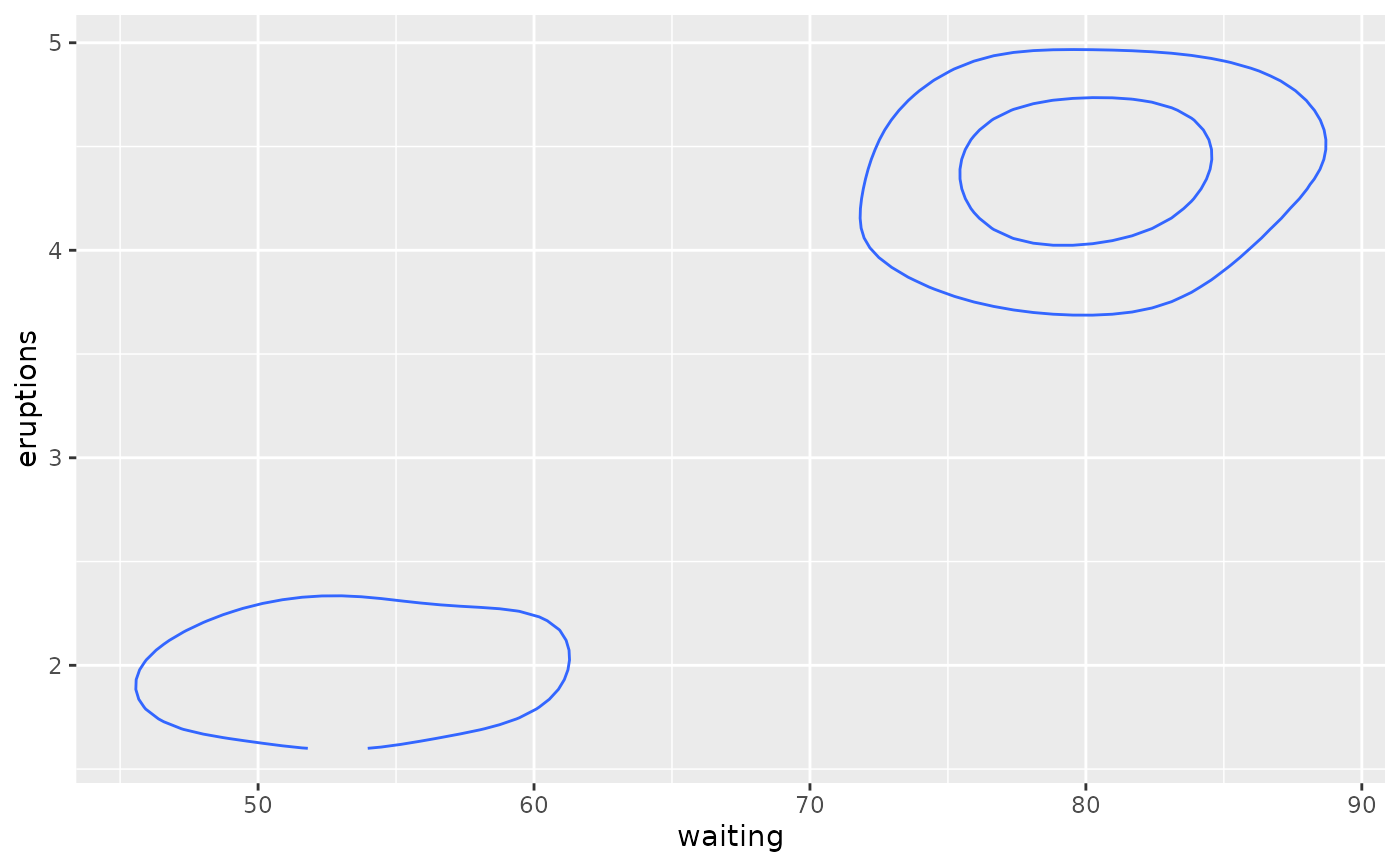 v + geom_contour (bins = v )
v + geom_contour (bins = v ) 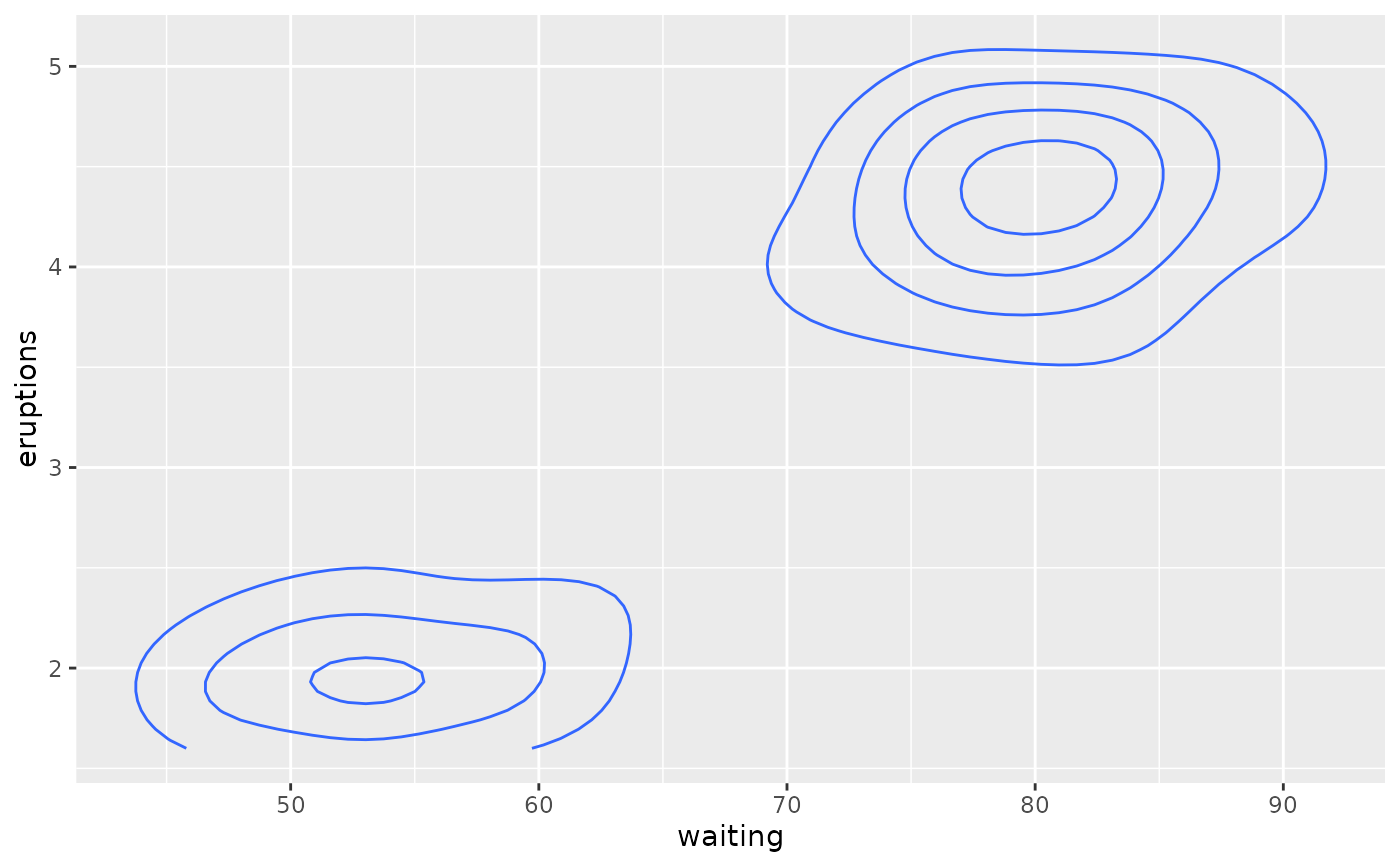 # Setting binwidth does the same affair, parameterised by the altitude # betwixt contours v + geom_contour (binwidth = 0.01 )
# Setting binwidth does the same affair, parameterised by the altitude # betwixt contours v + geom_contour (binwidth = 0.01 )  v + geom_contour (binwidth = 0.001 )
v + geom_contour (binwidth = 0.001 )  # Other parameters v + geom_contour ( aes (colour = after_stat ( level ) ) )
# Other parameters v + geom_contour ( aes (colour = after_stat ( level ) ) ) 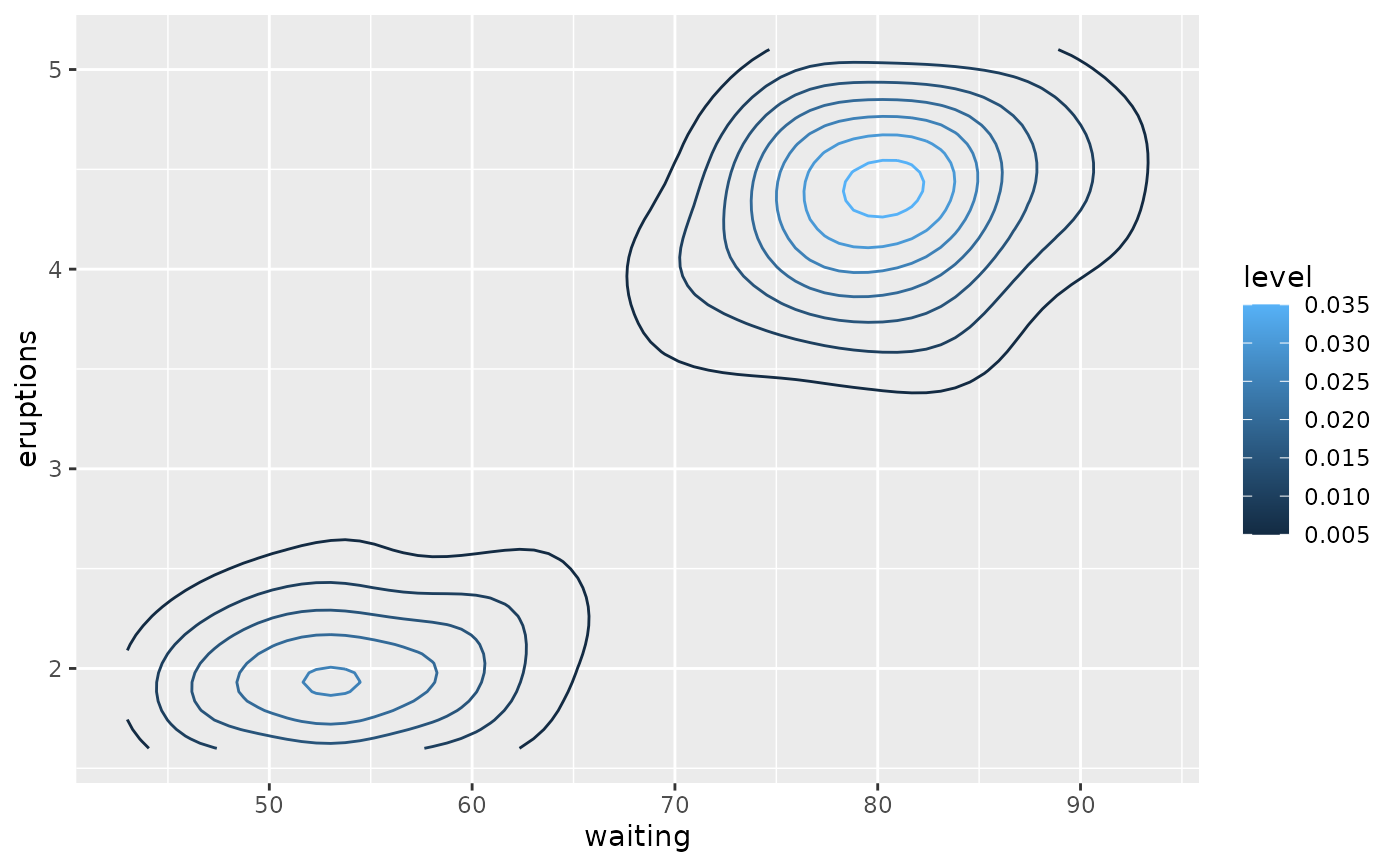 five + geom_contour (colour = "ruby-red" )
five + geom_contour (colour = "ruby-red" ) 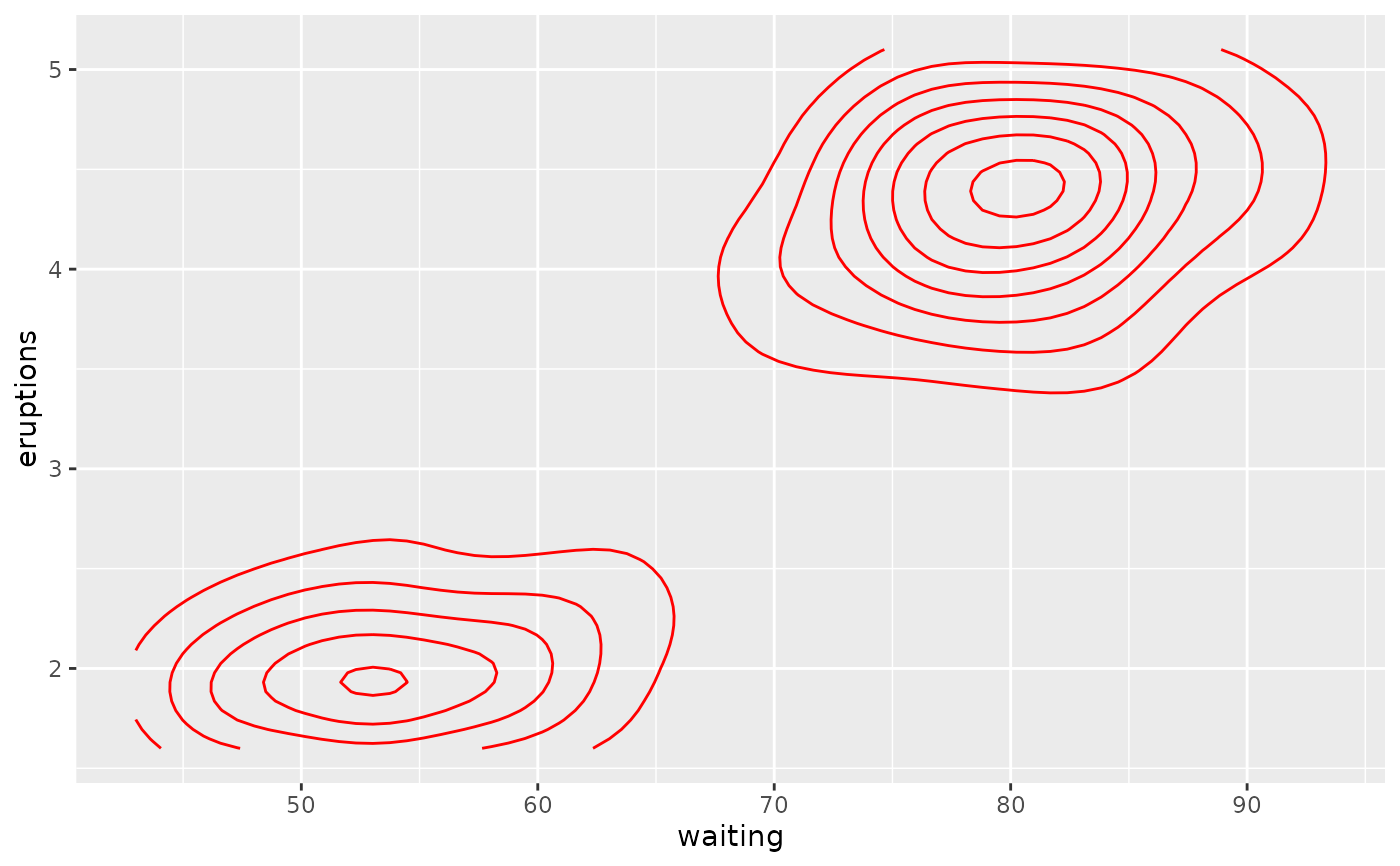 v + geom_raster ( aes (fill = density ) ) + geom_contour (colour = "white" )
v + geom_raster ( aes (fill = density ) ) + geom_contour (colour = "white" ) 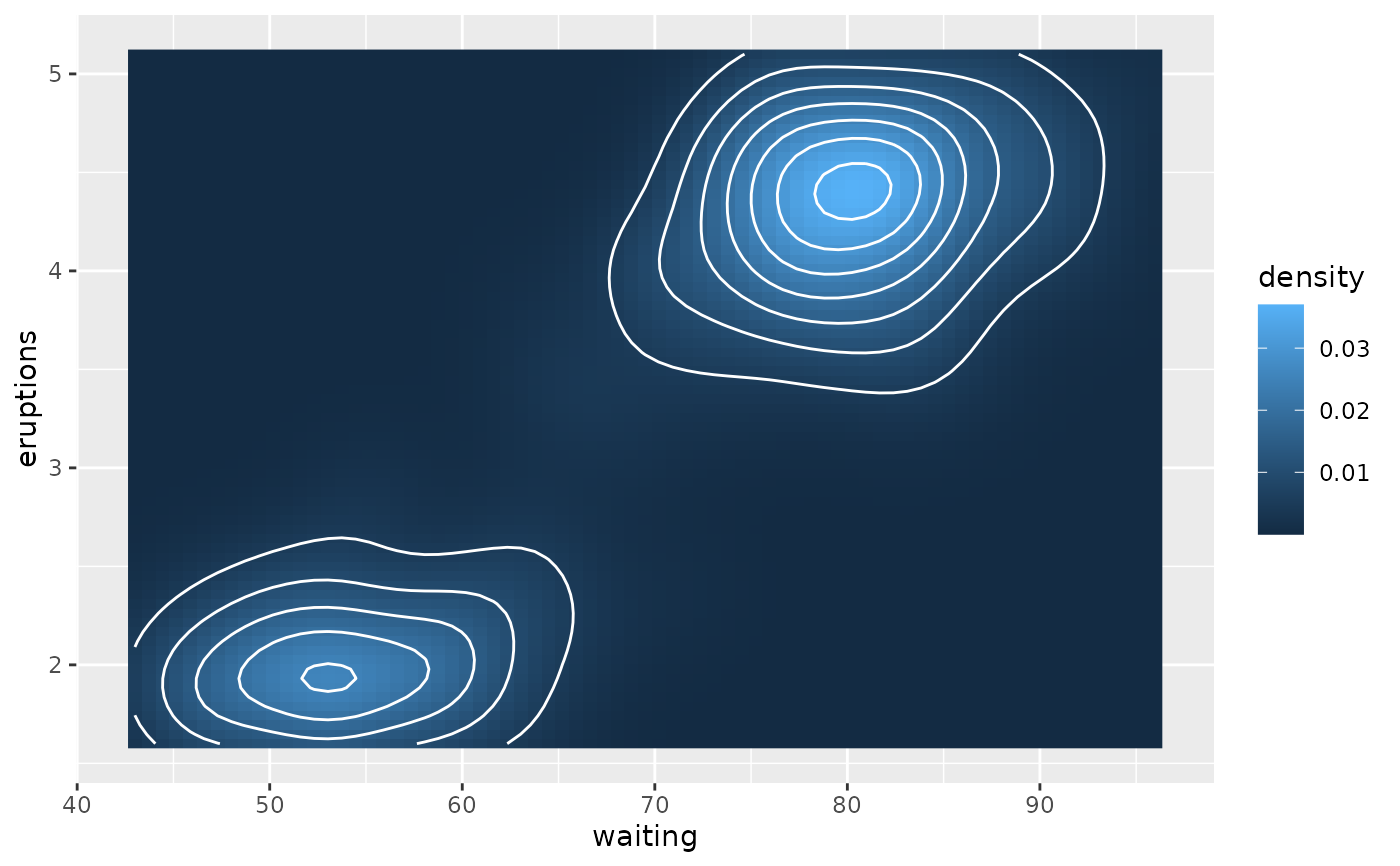 # Irregular data if ( requireNamespace ( "interp" ) ) { # Utilise a dataset from the interp parcel data ( franke, package = "interp" ) origdata <- as.data.frame ( interp :: franke.information ( ane, one, franke ) ) grid <- with ( origdata, interp :: interp ( x, y, z ) ) griddf <- subset ( data.frame (10 = rep ( grid $ x, nrow ( filigree $ z ) ), y = rep ( filigree $ y, each = ncol ( grid $ z ) ), z = every bit.numeric ( grid $ z ) ), ! is.na ( z ) ) ggplot ( griddf, aes ( x, y, z = z ) ) + geom_contour_filled ( ) + geom_point (data = origdata ) } else message ( "Irregular data requires the 'interp' packet" ) #> Loading required namespace: interp
# Irregular data if ( requireNamespace ( "interp" ) ) { # Utilise a dataset from the interp parcel data ( franke, package = "interp" ) origdata <- as.data.frame ( interp :: franke.information ( ane, one, franke ) ) grid <- with ( origdata, interp :: interp ( x, y, z ) ) griddf <- subset ( data.frame (10 = rep ( grid $ x, nrow ( filigree $ z ) ), y = rep ( filigree $ y, each = ncol ( grid $ z ) ), z = every bit.numeric ( grid $ z ) ), ! is.na ( z ) ) ggplot ( griddf, aes ( x, y, z = z ) ) + geom_contour_filled ( ) + geom_point (data = origdata ) } else message ( "Irregular data requires the 'interp' packet" ) #> Loading required namespace: interp 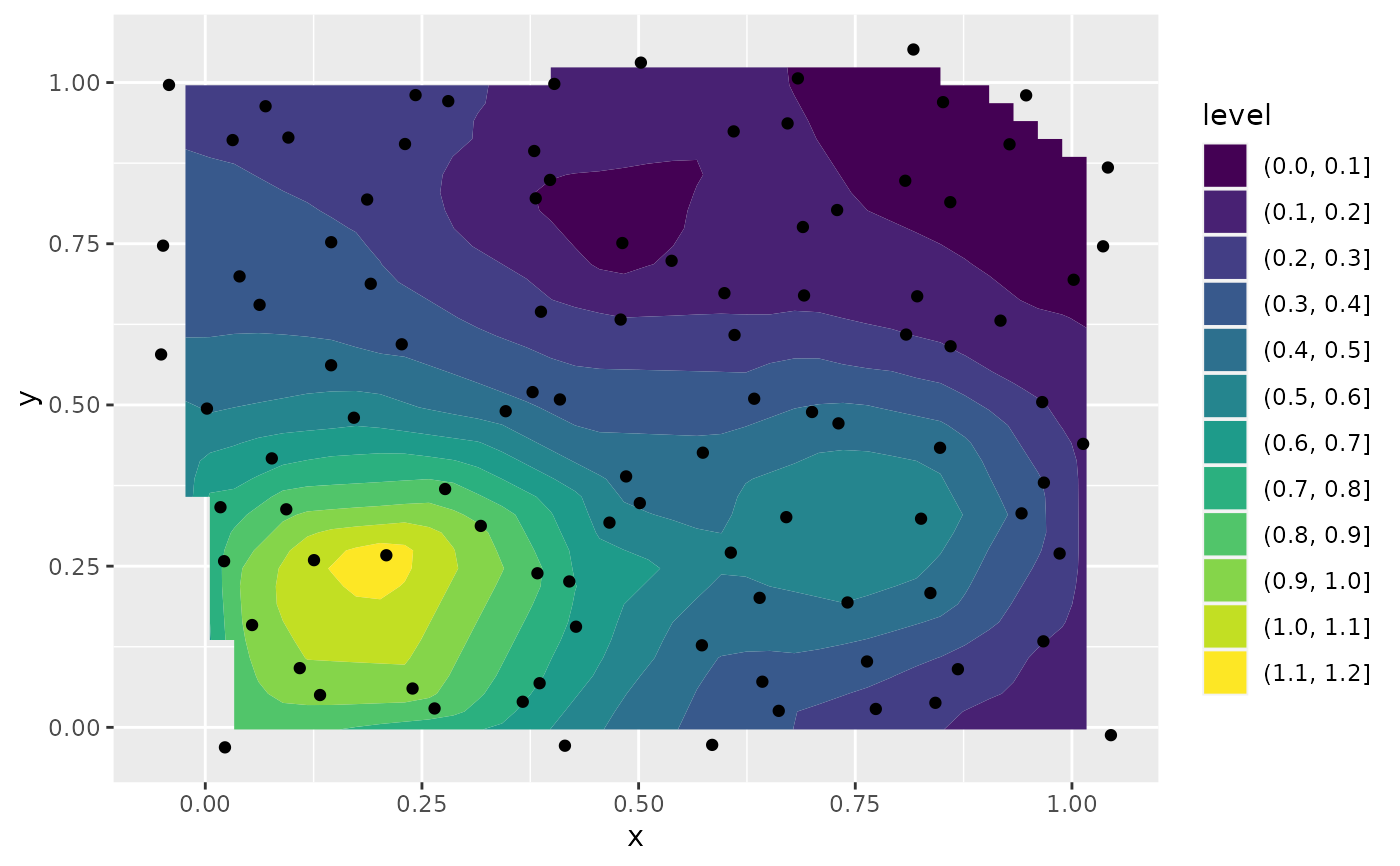 # }
# } constantinothinscion1974.blogspot.com
Source: https://ggplot2.tidyverse.org/reference/geom_contour.html
0 Response to "2 3d drawings contour lines"
Post a Comment